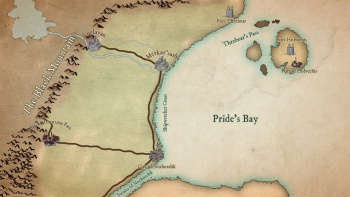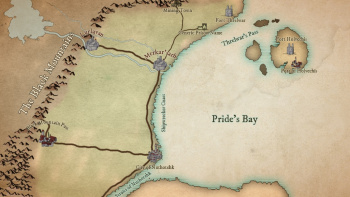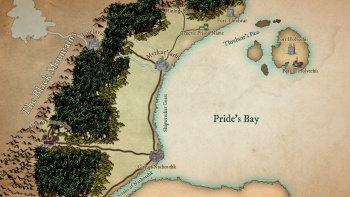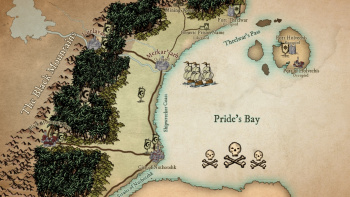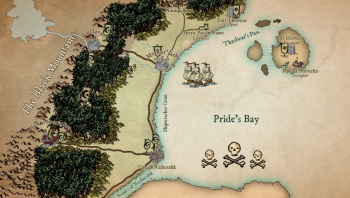Dread War
| Dread War | |
|---|---|
 | |
| Historical Event | |
| Event Name | Dread War |
| Dates and Times | February 19, 307 - November 9, 307 AC |
| Location | Teled Methen |
| People Involved | Regalian Empire and Crown Alliance, Altalar States, Dread Empire |
The Dread War was waged between the recently truced Regalian Empire with the Altalar States against the Dread Empire. As the Regalians came out of the Altalar-Regalian War, it became clear the fighting wasn't over as the Kathar forces then encroached further into Elven territory, as well as sent a minor Void-based plague to the City of Regalia. Faced against destruction, both Ailor and Altalar set aside their differences in order to combat their shared enemy. After a year long campaign, the Regalians and Altalar managed to push back the Dread Empire back to their borders, ending a three years conflict in Teled Methen. Today the Dread War is seen as a successful conclusion to a relatively stagnant war, and while some may consider the final battle pyrrhic, it did bring about positive relations between the Regalian Empire and Altalar Princes, a relationship which had been strained since the Ranger Crisis.
Background Information
The Dread War’s origins began during the final months of the Altalar-Regalian War. When the Regalian Empire pushed into the Elven Moors, military commanders expected to flank the Altalar forces in the Elven Cities from behind. What became reality, however, was a Kathar invasion coming from the southwest of the continent. Regalian troops were forced to retreat, and consequently spread a plague to the City of Regalia, which caused a brief moment of panic within the Ailor capital. When the plague was mysteriously cured, the Anglian Misery descended over the Lordship of Anglia, cutting off supplies to the front lines and the rest of the Archipelago for several months. During this time, the Regalian commanders and Altalar Princes agreed to an armistice, and before long had signed an unofficial truce between the two Empires, joining forces against the Kathar threat.
Eventually, the Anglian Misery ended, and before long the leadership of the Regalian Empire agreed to re-appoint Alexander Kade as Emperor, ending the year long Imperial Interregnum and re-centralizing Imperial Authority. As one of his first acts, Alexander appointed the decorated general William Howlester as Imperial Court Marshal and tasked him with creating a cabinet of the Empire’s top military minds. At the same time, news came from Field General Edgar Altenburg, a Regalian commander stationed in the Elven Cities, urging the Empire to immediately send as many forces as they could before the remaining forces were pushed back to the sea. With the Imperial Marshal Cabinet ordered to push the Dread Empire back and with time running out, the final campaign of the Long Elven War began.
History
The Invasion of Fort Threlwar
The opening battle began in the north of the Elven Moors, with the objective being to capture the Northern Fort Threlwar. Despite a landing force of 150,000 being difficult to hide from enemy forces, the months of inactivity on the Regalians’ side ultimately surprised the Kathar forces, who scrambled to their posts to try and prevent a beachhead. Under the oversight of Field General Ardigge Viduggla, the Regalian forces managed to establish their landing zone, forcing the enemy back. The final objective was the capture of the Fort itself, which was commanded by Kathar General Van’viilar Rovaknial and several Void Mage commanders. Under the command of Field General Hengest Harhold, the Regalian forces began phase two of their mission, and began to take the fort slowly.
Meanwhile at sea, an armada led by Wing Admiral Christopher Black was assailed by three bone ships of the Kathar Navy. During the naval engagements, the Dread forces were able to take control of an Anglian Frigate, forcing its crew to abandon ship as they prepared to continue their assault. Not willing to risk additional losses, the Wing Admiral gave the order to fire upon the Frigate and bone ships. In the end, two bone ships and the Anglian Frigate were sunk, with the third bone ship sailing back down south, ensuring that the Regalian Navy would have naval dominance in this opening engagement.
Back on land, General Viduggla sent out scouting parties around the area, while General Harhold was able to successfully push through the Fort’s garrison and succeeded in capturing the Kathar General inside. After several hours of reconnaissance, the Velheim general entered the Fort for the first time, where he came upon a gruesome sight. Under Harhold’s orders, soldiers chained all captured Kathar warriors in groups of ten, gouging the eyes of nine and cutting out the tongue of the tenth. He then ordered their release into the mountains, demanding they tell the tale of the Hound Lord that was coming to slaughter them all. Unfortunately, the Harhold’s actions did not stop there, as in a nearby cauldron the remains of Kathar General Van’viilar Rovaknial were boiled up alongside his Captains. True enough, word did reach the Dread forces further down in the City of Merkar’sarh, though unfortunately the enemy was willing to play tit for tat. In response, the Kathar decorated the outer walls of a nearby prison with the disfigured bodies of ten Regalian and Elven officers, dog skulls replacing their heads, and the body of Field General Altenburg. While the Regalians had succeeded in securing a base of operations, the actions of Harhold ultimately left mixed feelings with the Cabinet, especially as similar conduct had been seen with forces before during the Altalar-Regalian War.
Rival Orders and Liberations
With scouting reports coming back soon after taking Fort Threlwar, the Regalian Military learned of two key points that would prove difficult for full armies to capture: Neenasari Prison, where Field General Altenburg and the ten officers were executed at, and the supply town of Alynaneas. Tasked with taking back these two areas were the long term rivals of the Bloodcast and Viridian Orders, the latter of which also included a lone Turaal Blade. The Viridian mission was the first to begin, with a squad of Men-at-Arms and the Blade sneaking through the foliage until they reached the outer walls. It would be this one unarmored rogue that would prove key in the prison’s liberation, as he was able to move sneakily through the dark corridors while the knights slowly came behind. Eventually the group was discovered, with a brief battle being fought against the Regalians. During this moment, a few other knights began opening the cell doors for the prisoners, who in turn began to pick up random objects to fight against their captors. Eventually, the Kathar jailers were all defeated, though the Viridians suffered serious injuries, some even due to being trampled by the liberated soldiers. As for the lone Turaal Blade, he sustained few injuries, much to the Order’s chagrin.
When the news reached the Regalian Military that Neenasari Prison was liberated, the Bloodcast Order’s squad soon deployed to take back the town of Alynaneas. Rather than going in one large group, the Bloodcasts chose to split off into two teams, each taking a different side of the town. This would prove favorable later, as after the first team assaulted one of the Kathar night patrols, enemy reinforcements were forced to split up as well. While some of the knights did sustain several injuries, they were successful in liberating the town, which would turn out to be advantageous in the first large scale battle of the campaign.
The Siege of Merkar’sarh and Landing of Holvechis
With the Knightly Orders succeeding in the capture of their objectives came the first large scale battle of the campaign, the Siege of Merkar’sarh. Commanded by General Viduggla again, alongside General Harhold, General Siegfried von Rahm and supported by Prince Marshal Cedric Kade, the main army marched out supported by the recently promoted Division Admiral Christopher Black at sea. Unfortunately, the taking of Fort Threlwar had alerted the Dread leadership of the inevitable battle, and they had prepared defensive measures accordingly. Most notable were the two individuals in charge of the city: Blood Prince Valuiin'eron and Silver Tear Paladin Uneilan, one of the Dread Empire’s elite warriors which were reminiscent of the old Allorn Honor Guards.
The start of the battle began with both infantry lines moving to engage each other, with officers waiving their banners to rally their troops for the engagements. Unfortunately, this flurry of banners would confuse a Regalian Captain, mistaking them for the strategic signal that was to coordinate between both the Navy and Armies. Ordering the cannons to fire, the end result was the loss of hundreds of Dread and Regalian soldiers, with the Division Admiral forced to take charge of the situation. Back on land, the Harhold General moved into a flanking position, before he proudly proclaimed to his troops: “Fuck Ardige Viduggla, honestly!” As he gave the signal to flank the enemy, tribal Kathar forces from the western forests began to dash out and skirmish with the Harhold Army. While the fighting proved fierce, the Regalians were able to push back the counter flank, with the Harhold General politely suggesting for the Prince Marshal to transform into the Imperial Dragon, an action the former Emperor did on his own accord. As for the von Rahm Army, they fought the Silver Tear Paladin in the field alongside the main defenses, the latter of which utilizing dark Magic which the Regalians were not familiar with. In the end, however, the momentum was in favor of the Regalians, which forced the Paladin and the Blood Prince to abandon the city and retreat to the much larger city of Nuthotehk in the south of the Moors. With the city captured, the Generals proceeded to execute the remaining Kathar, liberating the city for the Altalar. For his second victory as a commander, Ardigge Viduggla was promoted to Field Marshal, a rank he held for the remainder of the war.
Elsewhere in the Moors, a second army commanded by Field General Baldur Norrvakt, the first Urlan to be seated on the Cabinet, was tasked with taking the nearby Isle of Holvechis, with the Regalian Military interested in utilizing it as a Naval outpost to command naval dominance in the theater. Landing on difficult terrain to avoid detection, the Field General ordered scouts to investigate the island’s main fort. After hours of no communication, the Norrvakt was forced to move his army slowly into the fort. Unfortunately, the Kathar had rigged the fort with traps, causing an explosion that would ultimately cripple the Urlan and render him unconscious. With their General incapacitated, command went to his brother Henrik, who continued to scout the island for traps, as well as the rest of the fort.
The rest of the island was much the same as the fort, in that the enemy had rigged many booby traps to deter Regalian forces. After taking many casualties, the army managed to reach the port town, but found it deserted. The fort meanwhile continued to play its death game, with a catacombs corridor mysteriously guarded by a Temple Orphan. In the only recorded history of a scouting party surviving the attack of this Magus, the group retreated from the fort, concluding that the entire isle was abandoned and unable to be utilized.
In total, the Siege and Expedition culminated in the loss of 26,000 Kathar troops and 16,200 Regalian casualties. Merkar’sarh was soon turned into the forward operating post for the Regalian Military, though would ultimately face several assaults by the Dread Empire in the battles to come.
The Massacre of the Lurlavan Forest and the Defense of Merkar’sarh
With Merkar’sarh taken, the Regalians now had two roads to advance down: the Forest Path that led west towards the city of Lurlavan, and the other path leading to the large city of Nothotehk. Choosing to focus on securing the north of the Moors, the Regalian Military tasked Marshal Viduggla alongside General Harhold and General von Rahm to march through the forests to take Lurlavan, while Imperial Marshal Howlester alongside Field Generals Ulric Typhonus and Dietrich von Drachenburg were tasked with defending Merkar’sarh from a Kathar counterattack.
The first army group to depart was the Viddugla-led groups, which began their trek through the dense forests. Unfortunately, the amount of men in each army slowed the Regalian advance to a standstill, and the concept of uniform marching was soon abandoned as the foliage crept up around the soldiers. As the armies advanced, their composition became more and more disorganized, which played right into the hands of the Kathar ambushers who had been shadowing the armies for miles. While the Regalians fought valiantly, they were unable to repel the endless waves of Kathar coming from the treetops, hidden tunnels in the forest, and other unknown areas. Faced with the possibility of losing three Cabinet members, the Regalians would ultimately be saved by the personal regiments commanded by Qar-Digmaan Yaotl, a Allar ally of the Regalian Empire. Through his Allar skirmishers, the Ailor armies were rescued from annihilation, though ultimately were forced to retreat back to Merkar’sarh, which was now facing a battle of its own.
Soon after the Viduggla armies departed, the Howlester groups began their slow march to the southern fields of the city. There they were met with Silver Tear Paladin Uneilan and two other Dread Champions, alongside three mysterious weapons controlled by Kathar Mages. As soon as both armies met each other, the Dread Mages began to utilize these weapons to create several golems made of blood. Wasting little time, the Howlester and Typhonus armies began to advance, while the Drachenburg kept his cavalry in reserves, wary of a Kathar ambush from the forest. As the battle continued, the Regalians were able to destroy one of the golems, and before long the remaining portions of the Regalian armies advanced, eliminating the other two with quick cavalry charges. With their weapons destroyed, the Dread soldiers were forced to retreat back to Nuthotehk, with the commanders knowing that the battle was only a simple test.
Back in Merkar’sarh, a garrion force led by Field General Dragomir du Brierüst was tasked with preparing the last line of defense should the Howlester force have failed. However, the General made a key error when he mentioned that non-Ailor would be expelled from the city should a siege be undertaken, an order that echoed in the Altalar halls of the city. Immediately the Elven emissaries distributed this news to the citizens, who immediately began to riot against their supposed Regalian allies. It would only be the return of the Howlester defense forces that would ultimately quell the riots, though the result of the Brierüst’s actions ultimately set the relations between Elf and Man back to the levels which started the Altalar-Regalian War.
The Attempt on Nuthotehk
With the failure to capture Lurlavan came the Regalian Military’s only other option: to march south to take the City of Nuthotehk. Leading the assault force was the Viduggla Marshal alongside Harhold and Field General Deo dei Termini, while a reinforcement group was left to secure the forests.Potential retreat was commanded by Marshal von Drachenburg, alongside Field Generals Aldwyn Howlester and Reimar Typhonus. Scouts had been sent to the city previously to report on the placement of several siege defenses, most notably the scorpion heavy bows of the Kathar. As the Viduggla-led group moved into position, the battle commenced.
Despite the six field armies deployed around the city, Nuthotehk proved to be impregnable to a direct assault. While some scorpions were able to be destroyed, the vast majority of them remained in use, repelling infantry units as they advanced. As for the reinforcements, they too became engaged with the Kathar ambushers, with the Drachenburg Marshal almost captured by a Kathar force that outmaneuvered the armies, though ultimately this endeavor was repelled by Typhonus led reinforcements. In short, the attempt to take Nuthotehk proved to be underprepared for, forcing the Marshal Cabinet to reevaluate their current plans in order to secure new victories.
Turning the Tides of War
After the failure of Nuthotehk, it was decided that another attempt at Lurlavan would be organized. This time it was overseen by Marshal von Drachenburg, and the forest path was eventually cleared by a single Field Army led by General Reimar Typhonus. Having seen the tribal Kathar combat strategy several times during the war, the General was able to clear the path towards Lurlavan, allowing for a proper Siege to take place.
The Battle of Lurlavan would prove to be the tactical victory that the Regalians were looking for. While scouting parties had determined the surrounding fields to be boggy and filled with cavalry traps, it would be the Typhonus Field General that would overcome the obstacle. In a fairly controversial move for Wirtem, the Field General recruited a few Silven to infiltrate the city gates posing as Dread Loyalists, once inside, the Aberrants began to make preparations for the imprisoned Altalar to revolt when a signal was given. What this signal was would be unknown to the infiltrators, though the Altalar agreed to be ready when the time came.
When the day of the battle arrived, two armies under Howlester and Typhonus were once again supervised by von Drachenburg, alongside the Prince Marshal. As the Regalian forces began to skirmish, the Typhonus plan was put into action. Transforming into the Imperial Dragon, the Prince Marshal descended on the outer walls, while the Altalar on the inside began to revolt, forcing the Kathar forces to retreat from the city. In addition, the token wilderness-born Kathar force that survived the first engagement with the Typhonus army was countered by the Howlester forces, ensuring that Lurlavan would fall into Regalian hands.
Meanwhile, Marshal Viduggla and General dei Termini prepared the city of Merkar’sarh for another defensive battle with the Kathar, which came as expected. With the Kathar Mages utilizing their magics alongside corrupted creatures from the Dread Empire, their focus was set on taking the city, not expecting the Regalians to have changed tactics since the last engagement. Unfortunately, this would be their undoing, as a third army under General Harhold was placed in hiding until the opportune time. This flank ultimately forced the Kathar to retreat once more, adding another victory to the Regalian tally.
The Battle of Lurlavan and the Second Defense of Merkar’sarh would prove to be a turning point in the war. The tactical plan of Field General Typhonus would be cited as one of the most notable throughout the entire campaign, which earned him much prestige after the battle concluded. Unfortunately, the liberation of the Northern Moors had one negative outcome which would ultimately set the scene of the final battle.
The Dance of the Dragons and the end of the Long Elven War
Scout reports came back quickly after Lurlavan was taken, each claiming that the Dread Empire had regrouped around the Black Mountain Pass which separated the Moors from the interior of Teled Methen. Most notable was the rumor of the Dread Dragon Rikirra accompanying the enemy forces, confirming suspicions that the perpetrator of the Dragon Crisis had fled to the Dread Empire after leaving the Holy City. Despite a large host preparing to march northwards, the news paled in comparison to the final report that came in: Nuthotehk was leveled to the ground. With the Marshal Cabinet given less than a week to prepare, all Field Armies were deployed south of Merkar’sarh, spanning from the forest to the coastline with the single objective of defeating the enemy.
The final battle of the Dread War tested every member of the Marshal Cabinet, both Generals and Admirals. On land, the Field Armies faced off against the greatest forces of the Dread Empire, with columns breaking and being reinforced by artillery and cavalry charges. At sea, the Imperial ships commanded by Division Admiral Black and Wing Admirals Karl-Gustav av Nystrom and Horatio de la Riviere fought a mysterious Kraken which they had encountered several weeks ago on reconnaissance. Despite all the Cabinet giving their all, the real battle would be fought in the skies.
With the Dread Dragon descending from the skies, the Prince Marshal once again transformed into the Imperial Dragon, returning to face his adversary that retreated roughly two years previously. Both creatures fought each other, utilizing their lightning breath to cause massive damage on the front lines. Eventually, the draconic duo moved the battle into the City of Merkar’sarh itself, where a reserve force under Field Commander Garth Viduggla was kept in reserve under Imperial Marshal Howlester’s direct orders. This decision would prove favorable, as Rikirra and Prince Cedric would face off in the city streets, returning to human form, with the former utilizing dark magic to turn the Witchbloods in the vicinity against their comrades in arms, an action which prompted the Prince to continue to fight her. Battered and beaten, the two would briefly converse in Wyrm Tongue, before they followed up with an unexpected action. With both transforming back into their Dragon forms, they rose into the skies, before disappearing from the battle. At this point, all Witchbloods regained their senses, though were ultimately detained by the military for the remainder of the battle.
The effects of the Dragons’ departure would quickly be seen on the front lines. The Kathar creatures began to disappear, with several Mages unable to use their arcane abilities. Even the monstrous Kraken disappeared into the waves, leaving the Navy with the seas at their control. Having lost their source of power, the Kathar forces buckled and began to retreat over the Black Mountains, back to their Empire. There was little celebration after the battle, but rather a sense of relief. Having started the Altalar-Regalian War years ago, the Regalian Military was finally able to say that the war was over, with the soldiers finally returning back to their families and previous lives.
Effects
The Dread War served as the final chapter of the Long Elven War. While many considered the final battle to be pyrrhic in nature, many would agree that any conclusion to the prolonged conflict was a positive. Most notable were the actions of Reimar Typhonus, who while only a recent graduate of the Marshalry Academy was awarded the Crystal Heart Medal and granted a barony by the Regalian Emperor. The Dread War also saw several controversial awardees granted medals, most notable being a Vampire Brood and a Manathar, both female, indicating to everyone that the military was seeing changes, whether the hardline conservative elements wanted it or not.
Finally, the largest criticism following the Dread War was the perception that nothing was gained. While the Long Elven War started out as a way to defeat the Magic Covenant and subjugate the Altalar, political complacency from the seated Lord Chancellor ultimately saw the diplomatic channel closed. While private endeavors ultimately reopened a single channel, the bargaining power of the Regalian Empire waned as time went on, ultimately leading to the Successor States returning to status quo in late 307 AC, with the belief that the Regalians never truly wanted them to join their Empire.
Trivia
- The Dread War was one of the few recent conflicts which saw very little political machinations affecting the military progress in the field. This was in stark contrast to the Altalar-Regalian War, which saw several reshuffles and stalemates that lasted for weeks.
- With the conclusion of the Dread War came the question of repaying war bonds to those who supported the military. This caused a massive deficit on the Regalian State, which is still trying to pay back all debts.
- Peace was short lived in the Regalian Empire following the Long Elven War, as political stagnation ultimately led to several realms breaking off ties from the central government and declaring rebellions. While these have all concluded, it showed that the Regalian State was unable to control its own subjects, which ultimately made attempts to integrate the Altalar States into the Empire fall on deaf ears.
| ||||||||||||||||||||||
| Accreditation | |||||||
|---|---|---|---|---|---|---|---|
|
| ||||||
